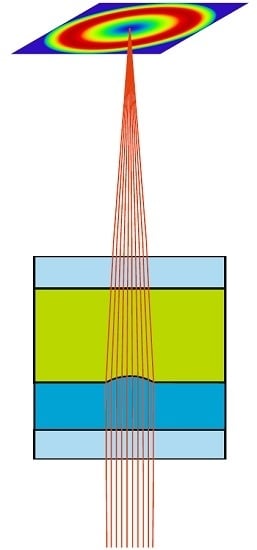Recent Developments in Optofluidic Lens Technology
Abstract
:1. Introduction
2. General Characteristics of Optofluidics Lenses
2.1. Liquid Lens Shapes and Actuation Principles
2.2. Quantification of Optical Aberrations and Lens Shapes
2.3. Quantification of Optical Performance
2.4. Materials and Design Considerations
3. Spherical Lenses
3.1. Thermally Driven Lenses
3.2. Pneumatically Driven Lenses
3.3. Stimuli-Responsive Lenses
3.4. Electrically Driven Lenses
4. Non-Spherical Lenses
4.1. Electrically Driven Aspherical and Cylindrical Lenses
4.2. Thermally Driven Lenses
4.3. Mechanically Driven Lenses
4.4. Hydrodynamically Driven Lenses
5. Outlook: Advanced Optofluidic Imaging Systems for the Future
6. Conclusions
Acknowledgments
Author Contributions
Conflicts of Interest
References
- Erickson, D.; Sinton, D.; Psaltis, D. Optofluidics for energy applications. Nat. Photonics 2011, 5, 583–590. [Google Scholar] [CrossRef]
- Fan, X.D.; White, I.M. Optofluidic microsystems for chemical and biological analysis. Nat. Photonics 2011, 5, 591–597. [Google Scholar] [CrossRef] [PubMed]
- Schmidt, H.; Hawkins, A.R. The photonic integration of non-solid media using optofluidics. Nat. Photonics 2011, 5, 598–604. [Google Scholar] [CrossRef]
- Pang, L.; Chen, H.M.; Freeman, L.M.; Fainman, Y. Optofluidic devices and applications in photonics, sensing and imaging. Lab Chip 2012, 12, 3543–3551. [Google Scholar] [CrossRef] [PubMed]
- Chen, Y.F.; Jiang, L.; Mancuso, M.; Jain, A.; Oncescu, V.; Erickson, D. Optofluidic opportunities in global health, food, water and energy. Nanoscale 2012, 4, 4839–4857. [Google Scholar] [CrossRef] [PubMed]
- Nguyen, N.T. Micro-optofluidic lenses: A review. Biomicrofluidics 2010, 4, 031501. [Google Scholar] [CrossRef] [PubMed]
- Berge, B.; Peseux, J. Variable focal lens controlled by an external voltage: An application of electrowetting. Eur. Phys. J. E 2000, 3, 159–163. [Google Scholar] [CrossRef]
- Kuiper, S.; Hendriks, B.H.W. Variable-focus liquid lens for miniature cameras. Appl. Phys. Lett. 2004, 85, 1128–1130. [Google Scholar] [CrossRef]
- Krupenkin, T.; Yang, S.; Mach, P. Tunable liquid microlens. Appl. Phys. Lett. 2003, 82, 316–318. [Google Scholar] [CrossRef]
- Liu, C.X.; Park, J.; Choi, J.W. A planar lens based on the electrowetting of two immiscible liquids. J. Micromech. Microeng. 2008, 18, 035023. [Google Scholar] [CrossRef]
- Murade, C.U.; van der Ende, D.; Mugele, F. High speed adaptive liquid microlens array. Opt. Express 2012, 20, 18180–18187. [Google Scholar] [CrossRef] [PubMed]
- Moran, P.M.; Dharmatilleke, S.; Khaw, A.H.; Tan, K.W.; Chan, M.L.; Rodriguez, I. Fluidic lenses with variable focal length. Appl. Phys. Lett. 2006, 88, 041120. [Google Scholar] [CrossRef]
- Lee, S.N.; Tung, H.W.; Chen, W.C.; Fang, W.L. Thermal actuated solid tunable lens. IEEE Photonic Technol. Lett. 2006, 18, 2191–2193. [Google Scholar] [CrossRef]
- Zhang, W.; Zappe, H.; Seifert, A. Wafer-scale fabricated thermo-pneumatically tunable microlenses. Light Sci. Appl. 2014, 3, e145. [Google Scholar] [CrossRef]
- Zhang, W.; Aljasem, K.; Zappe, H.; Seifert, A. Completely integrated, thermo-pneumatically tunable microlens. Opt. Express 2011, 19, 2347–2362. [Google Scholar] [CrossRef] [PubMed]
- Hung, K.-Y.; Hsiao, P.-J.; Tseng, F.-G.; Wei, M.-C. From spheric to aspheric solid polymer lenses: A review. Adv. OptoElectron. 2011, 2011, 197549. [Google Scholar] [CrossRef]
- Roy, A.C.; Ghatak, A. Design of an adaptable optofluidic aspherical lens by using the elastocapillary effect. Adv. Opt. Mater. 2014, 2, 874–878. [Google Scholar] [CrossRef]
- Liebetraut, P.; Petsch, S.; Liebeskind, J.; Zappe, H. Elastomeric lenses with tunable astigmatism. Light Sci. Appl. 2013, 2, e98. [Google Scholar] [CrossRef]
- Liebetraut, P.; Waibel, P.; Nguyen, P.H.C.; Reith, P.; Aatz, B.; Zappe, H. Optical properties of liquids for fluidic optics. Appl. Opt. 2013, 52, 3203–3215. [Google Scholar] [CrossRef] [PubMed]
- Mao, X.L.; Lin, S.C.S.; Lapsley, M.I.; Shi, J.J.; Juluri, B.K.; Huang, T.J. Tunable liquid gradient refractive index (L-GRIN) lens with two degrees of freedom. Lab Chip 2009, 9, 2050–2058. [Google Scholar] [CrossRef] [PubMed]
- Chen, Q.M.; Jian, A.Q.; Li, Z.H.; Zhang, X.M. Optofluidic tunable lenses using laser-induced thermal gradient. Lab Chip 2016, 16, 104–111. [Google Scholar] [CrossRef] [PubMed]
- Lakshminarayanan, V.; Fleck, A. Zernike polynomials: A guide. J. Mod. Opt. 2011, 58, 545–561. [Google Scholar] [CrossRef]
- Li, C.H.; Hall, G.; Zhu, D.F.; Li, H.; Eliceiri, K.W.; Jiang, H.R. Three-dimensional surface profile measurement of microlenses using the shack-hartmann wavefront sensor. J. Microelectromech. Syst. 2012, 21, 530–540. [Google Scholar] [CrossRef]
- Li, C.H.; Hall, G.; Zeng, X.F.; Zhu, D.F.; Eliceiri, K.; Jiang, H.R. Three-dimensional surface profiling and optical characterization of liquid microlens using a shack-hartmann wave front sensor. Appl. Phys. Lett. 2011, 98, 171104. [Google Scholar] [CrossRef] [PubMed]
- Santiago-Alvarado, A.; Vázquez-Montiel, S.; Granados-Agustín, F.; Munoz-López, J.; Percino-Zacarias, E.; González-García, J. Functional characterization of a liquid lens using a ZYgoTM Interferometer. Proc. SPIE 2009, 7499. [Google Scholar] [CrossRef]
- Li, Q.H.; Shao, X.P. Spherical aberration and modulation transfer function. Proc. SPIE 2014, 9124. [Google Scholar] [CrossRef]
- Krogmann, F.; Monch, W.; Zappe, H. Electrowetting for tunable microoptics. J. Microelectromech. Syst. 2008, 17, 1501–1512. [Google Scholar] [CrossRef]
- Li, F.; Mugele, F. How to make sticky surfaces slippery: Contact angle hysteresis in electrowetting with alternating voltage. Appl. Phys. Lett. 2008, 92, 244108. [Google Scholar] [CrossRef]
- Waibel, P.; Mader, D.; Liebetraut, P.; Zappe, H.; Seifert, A. Chromatic aberration control for tunable all-silicone membrane microlenses. Opt. Express 2011, 19, 18584–18592. [Google Scholar] [CrossRef] [PubMed]
- Oh, J.M.; Legendre, D.; Mugele, F. Shaken not stirred—On internal flow patterns in oscillating sessile drops. EPL Europhys. Lett. 2012, 98, 34003. [Google Scholar] [CrossRef]
- Lopez, C.A.; Hirsa, A.H. Fast focusing using a pinned-contact oscillating liquid lens. Nat. Photonics 2008, 2, 610–613. [Google Scholar] [CrossRef]
- Kyle, C.; Fainman, Y.; Groisman, A. Pneumatically actuated adaptive lenses with millisecond response time. Appl. Phys. Lett. 2007, 91, 171111. [Google Scholar]
- Reichelt, S.; Zappe, H. Design of spherically corrected, achromatic variable-focus liquid lenses. Opt. Express 2007, 15, 14146–14154. [Google Scholar] [CrossRef] [PubMed]
- Lopez, C.A.; Lee, C.C.; Hirsa, A.H. Electrochemically activated adaptive liquid lens. Appl. Phys. Lett. 2005, 87, 134102. [Google Scholar] [CrossRef]
- Dong, L.; Agarwal, A.K.; Beebe, D.J.; Jiang, H.R. Adaptive liquid microlenses activated by stimuli-responsive hydrogels. Nature 2006, 442, 551–554. [Google Scholar] [CrossRef] [PubMed]
- Zhu, D.F.; Li, C.H.; Zeng, X.F.; Jiang, H.R. Tunable-focus microlens arrays on curved surfaces. Appl. Phys. Lett. 2010, 96, 081111. [Google Scholar] [CrossRef]
- Schuhladen, S.; Preller, F.; Rix, R.; Petsch, S.; Zentel, R.; Zappe, H. Iris-like tunable aperture employing liquid-crystal elastomers. Adv. Mater. 2014, 26, 7247–7251. [Google Scholar] [CrossRef] [PubMed]
- Ren, H.W.; Fox, D.; Anderson, P.A.; Wu, B.; Wu, S.T. Tunable-focus liquid lens controlled using a servo motor. Opt. Express 2006, 14, 8031–8036. [Google Scholar] [CrossRef] [PubMed]
- Werber, A.; Zappe, H. Tunable microfluidic microlenses. Appl. Opt. 2005, 44, 3238–3245. [Google Scholar] [CrossRef] [PubMed]
- Choi, H.; Han, D.S.; Won, Y.H. Adaptive double-sided fluidic lens of polydimethylsiloxane membranes of matching thickness. Opt. Lett. 2011, 36, 4701–4703. [Google Scholar] [CrossRef] [PubMed]
- Chronis, N.; Liu, G.L.; Jeong, K.H.; Lee, L.P. Tunable liquid-filled microlens array integrated with microfluidic network. Opt. Express 2003, 11, 2370–2378. [Google Scholar] [CrossRef] [PubMed]
- Beadie, G.; Sandrock, M.L.; Wiggins, M.J.; Lepkowicz, R.S.; Shirk, J.S.; Ponting, M.; Yang, Y.; Kazmierczak, T.; Hiltner, A.; Baer, E. Tunable polymer lens. Opt. Express 2008, 16, 11847–11857. [Google Scholar] [CrossRef] [PubMed]
- Zeng, X.F.; Jiang, H.R. Tunable liquid microlens actuated by infrared light-responsive hydrogel. Appl. Phys. Lett. 2008, 93, 151101. [Google Scholar] [CrossRef]
- Miccio, L.; Memmolo, P.; Merola, F.; Netti, P.A.; Ferraro, P. Red blood cell as an adaptive optofluidic microlens. Nat. Commun. 2015, 6, 6502. [Google Scholar] [CrossRef] [PubMed]
- Hou, L.; Smith, N.R.; Heikenfeld, J. Electrowetting manipulation of any optical film. Appl. Phys. Lett. 2007, 90, 251114. [Google Scholar] [CrossRef]
- Hagedon, M.; Yang, S.; Russell, A.; Heikenfeld, J. Bright e-paper by transport of ink through a white electrofluidic imaging film. Nat. Commun. 2012, 3, 1173. [Google Scholar] [CrossRef] [PubMed]
- Mugele, F.; Baret, J.C. Electrowetting: From basics to applications. J. Phys. Condens. Matter 2005, 17, R705–R774. [Google Scholar] [CrossRef]
- Krogmann, F.; Monch, W.; Zappe, H. A mems-based variable micro-lens system. J. Opt. A Pure Appl. Opt. 2006, 8, S330–S336. [Google Scholar] [CrossRef]
- Lee, S.L.; Yang, C.F. Numerical simulation for meniscus shape and optical performance of a MEMS-based liquid micro-lens. Opt. Express 2008, 16, 19995–20007. [Google Scholar] [CrossRef] [PubMed]
- Yu, H.B.; Guo, B.; Tsu-Hui, A.L.; Lin, J.T.M.; Yee, T.B. Characterization of the dynamic mechanical stability of liquid-filled lenses. Opt. Express 2012, 20, 23720–23727. [Google Scholar] [CrossRef] [PubMed]
- Ren, H.W.; Xianyu, H.Q.; Xu, S.; Wu, S.T. Adaptive dielectric liquid lens. Opt. Express 2008, 16, 14954–14960. [Google Scholar] [CrossRef] [PubMed]
- Cheng, C.C.; Yeh, J.A. Dielectrically actuated liquid lens. Opt. Express 2007, 15, 7140–7145. [Google Scholar] [CrossRef] [PubMed]
- Cheng, C.C.; Chang, C.A.; Yeh, J.A. Variable focus dielectric liquid droplet lens. Opt. Express 2006, 14, 4101–4106. [Google Scholar] [CrossRef] [PubMed]
- Grilli, S.; Miccio, L.; Vespini, V.; Finizio, A.; de Nicola, S.; Ferraro, P. Liquid micro-lens array activated by selective electrowetting on lithium niobate substrates. Opt. Express 2008, 16, 8084–8093. [Google Scholar] [CrossRef] [PubMed]
- Miccio, L.; Finizio, A.; Grilli, S.; Vespini, V.; Paturzo, M.; De Nicola, S.; Ferraro, P. Tunable liquid microlens arrays in electrode-less configuration and their accurate characterization by interference microscopy. Opt. Express 2009, 17, 2487–2499. [Google Scholar] [CrossRef] [PubMed]
- Gorman, C.B.; Biebuyck, H.A.; Whitesides, G.M. Control of the shape of liquid lenses on a modified gold surface using an applied electrical potential across a self-assembled monolayer. Langmuir 1995, 11, 2242–2246. [Google Scholar] [CrossRef]
- Lee, S.W.; Lee, S.S. Focal tunable liquid lens integrated with an electromagnetic actuator. Appl. Phys. Lett. 2007, 90, 121129. [Google Scholar] [CrossRef]
- Choi, S.T.; Lee, J.Y.; Kwon, J.O.; Lee, S.; Kim, W. Varifocal liquid-filled microlens operated by an electroactive polymer actuator. Opt. Lett. 2011, 36, 1920–1922. [Google Scholar] [CrossRef] [PubMed]
- Xu, S.; Lin, Y.J.; Wu, S.T. Dielectric liquid microlens with well-shaped electrode. Opt. Express 2009, 17, 10499–10505. [Google Scholar] [CrossRef] [PubMed]
- Zhang, W.; Aljasem, K.; Zappe, H.; Seifert, A. Highly flexible MTF measurement system for tunable micro lenses. Opt. Express 2010, 18, 12458–12469. [Google Scholar] [CrossRef] [PubMed]
- Lima, N.C.; Cavalli, A.; Mishra, K.; Mugele, F. Numerical simulation of astigmatic liquid lenses tuned by a stripe electrode. Opt. Express 2016, 24, 4210–4220. [Google Scholar] [CrossRef] [PubMed]
- Oh, J.M.; Manukyan, G.; van den Ende, D.; Mugele, F. Electric-field-driven instabilities on superhydrophobic surfaces. EPL Europhys. Lett. 2011, 93, 56001. [Google Scholar] [CrossRef]
- Zhan, Z.X.; Wang, K.Y.; Yao, H.T.; Cao, Z.L. Fabrication and characterization of aspherical lens manipulated by electrostatic field. Appl. Opt. 2009, 48, 4375–4380. [Google Scholar] [CrossRef] [PubMed]
- Kuo, S.M.; Lin, C.H. Fabrication of aspherical su-8 microlens array utilizing novel stamping process and electrostatic pulling method. Opt. Express 2010, 18, 19114–19119. [Google Scholar] [CrossRef] [PubMed]
- Mishra, K.; Murade, C.; Carreel, B.; Roghair, I.; Oh, J.M.; Manukyan, G.; van den Ende, D.; Mugele, F. Optofluidic lens with tunable focal length and asphericity. Sci. Rep. 2014, 4, 6378. [Google Scholar] [CrossRef] [PubMed]
- Ren, H.W.; Fan, Y.H.; Gauza, S.; Wu, S.T. Tunable-focus cylindrical liquid crystal lens. Jpn J. Appl. Phys. 2004, 43, 652–653. [Google Scholar] [CrossRef]
- Miccio, L.; Paturzo, M.; Grilli, S.; Vespini, V.; Ferraro, P. Hemicylindrical and toroidal liquid microlens formed by pyro-electro-wetting. Opt. Lett. 2009, 34, 1075–1077. [Google Scholar] [CrossRef] [PubMed]
- Lee, S.Y.; Tung, H.W.; Chen, W.C.; Fang, W. Novel micro lens with tunable astigmatism. In Proceedings of the TRANSDUCERS 2007—2007 International Solid-State Sensors, Actuators and Microsystems Conference, Lyon, France, 10–14 June 2007; pp. 2147–2150.
- Yu, H.B.; Zhou, G.Y.; Leung, H.M.; Chau, F.S. Tunable liquid-filled lens integrated with aspherical surface for spherical aberration compensation. Opt. Express 2010, 18, 9945–9954. [Google Scholar] [CrossRef] [PubMed]
- Zhao, P.P.; Ataman, C.; Zappe, H. An endoscopic microscope with liquid-tunable aspheric lenses for continuous zoom capability. Proc. SPIE 2014, 9130. [Google Scholar] [CrossRef]
- Mao, X.L.; Waldeisen, J.R.; Juluri, B.K.; Huang, T.J. Hydrodynamically tunable optofluidic cylindrical microlens. Lab Chip 2007, 7, 1303–1308. [Google Scholar] [CrossRef] [PubMed]
- Zhao, W.X.; Liang, D.; Zhang, J.; Liu, C.; Zang, S.F.; Wang, Q.H. Variable-focus cylindrical liquid lens array. In Proceedings of the International Conference on Optics in Precision Engineering and Nanotechnology (Icopen2013), Singapore, Singapore, 9–11 April 2013; Volume 8769.
- Marks, R.; Mathine, D.L.; Peyman, G.; Schwiegerling, J.; Peyghambarian, N. Adjustable adaptive compact fluidic phoropter with no mechanical translation of lenses. Opt. Lett. 2010, 35, 739–741. [Google Scholar] [CrossRef] [PubMed]
- Brown, C.V.; Wells, G.G.; Newton, M.I.; McHale, G. Voltage-programmable liquid optical interface. Nat. Photonics 2009, 3, 403–405. [Google Scholar] [CrossRef]
- Heikenfeld, J.; Zhou, K.; Kreit, E.; Raj, B.; Yang, S.; Sun, B.; Milarcik, A.; Clapp, L.; Schwartz, R. Electrofluidic displays using young-laplace transposition of brilliant pigment dispersions. Nat. Photonics 2009, 3, 292–296. [Google Scholar] [CrossRef]
- Won, Y.H. Electrowetting-based adaptive vari-focal liquid lens array for 3D display. Proc. SPIE 2014, 9270. [Google Scholar] [CrossRef]
- Murade, C.U.; Oh, J.M.; van den Ende, D.; Mugele, F. Electrowetting driven optical switch and tunable aperture. Opt. Express 2011, 19, 15525–15531. [Google Scholar] [CrossRef] [PubMed]
- Smith, N.R.; Abeysinghe, D.C.; Haus, J.W.; Heikenfeld, J. Agile wide-angle beam steering with electrowetting microprisms. Opt. Express 2006, 14, 6557–6563. [Google Scholar] [CrossRef] [PubMed]
- Kilaru, M.K.; Yang, J.; Heikenfeld, J. Advanced characterization of electrowetting retroreflectors. Opt. Express 2009, 17, 17563–17569. [Google Scholar] [CrossRef] [PubMed]
- Schuhladen, S.; Banerjee, K.; Stürmer, M.; Müller, P.; Wallrabe, U.; Zappe, H. Variable optofluidic slit aperture. Light Sci. Appl. 2016, 5, e16005. [Google Scholar] [CrossRef]
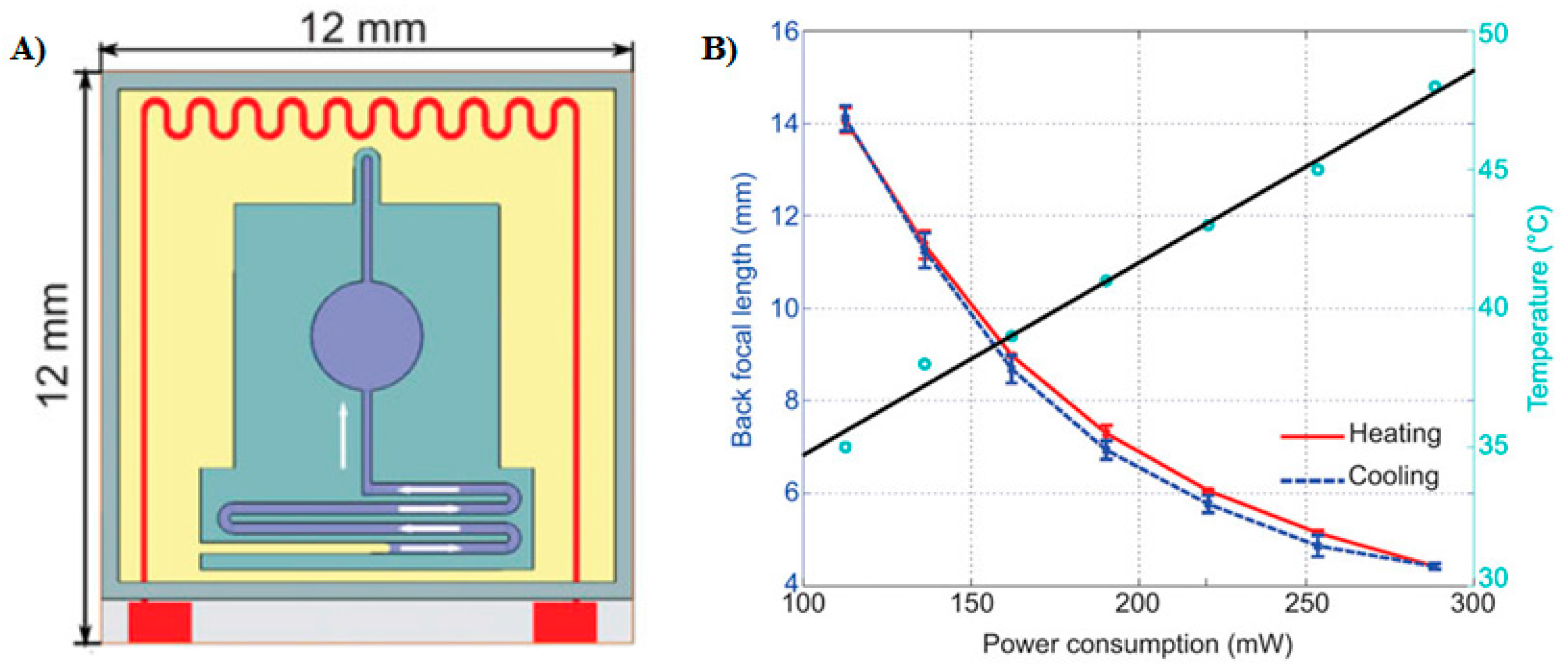

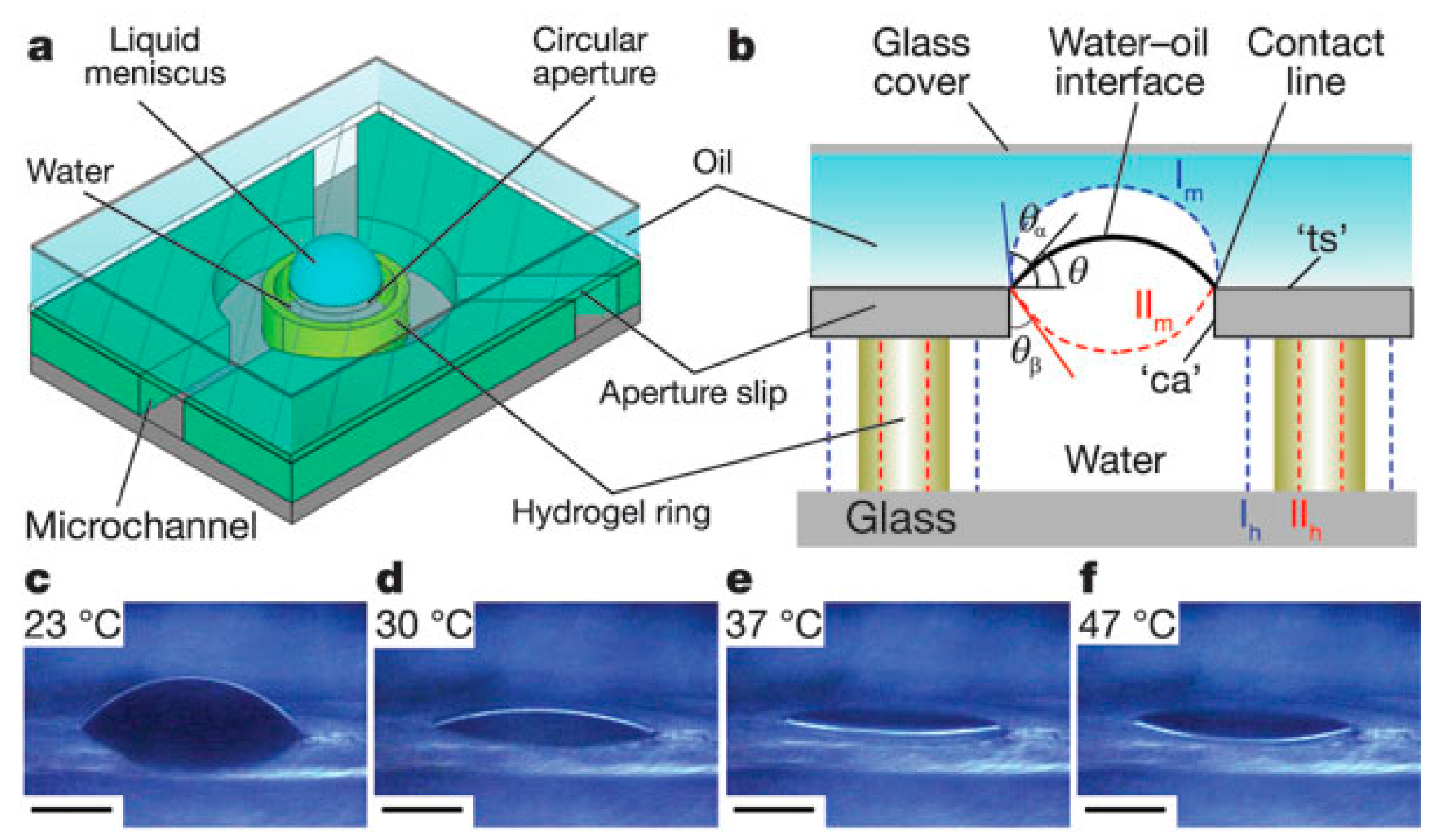
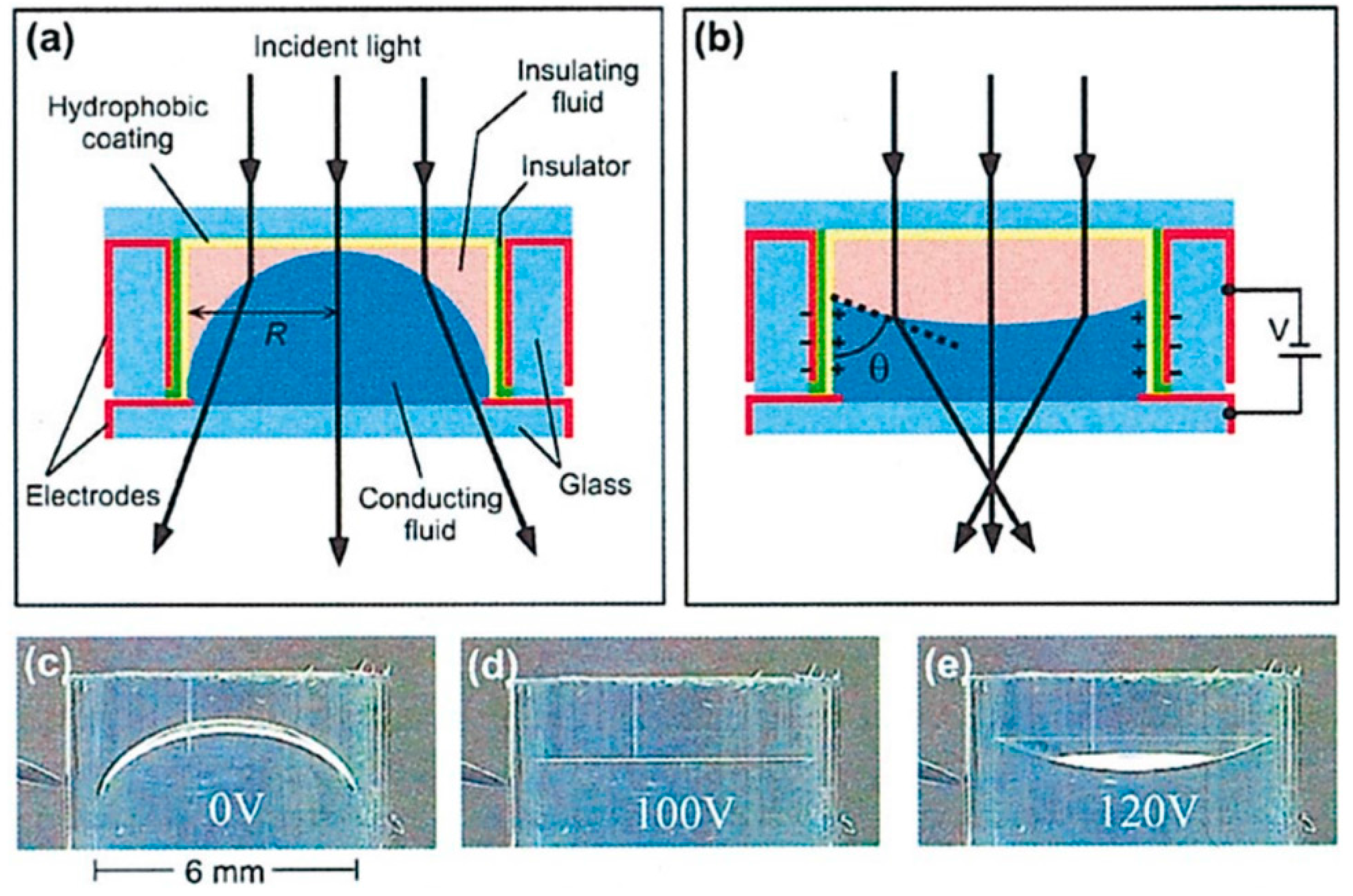
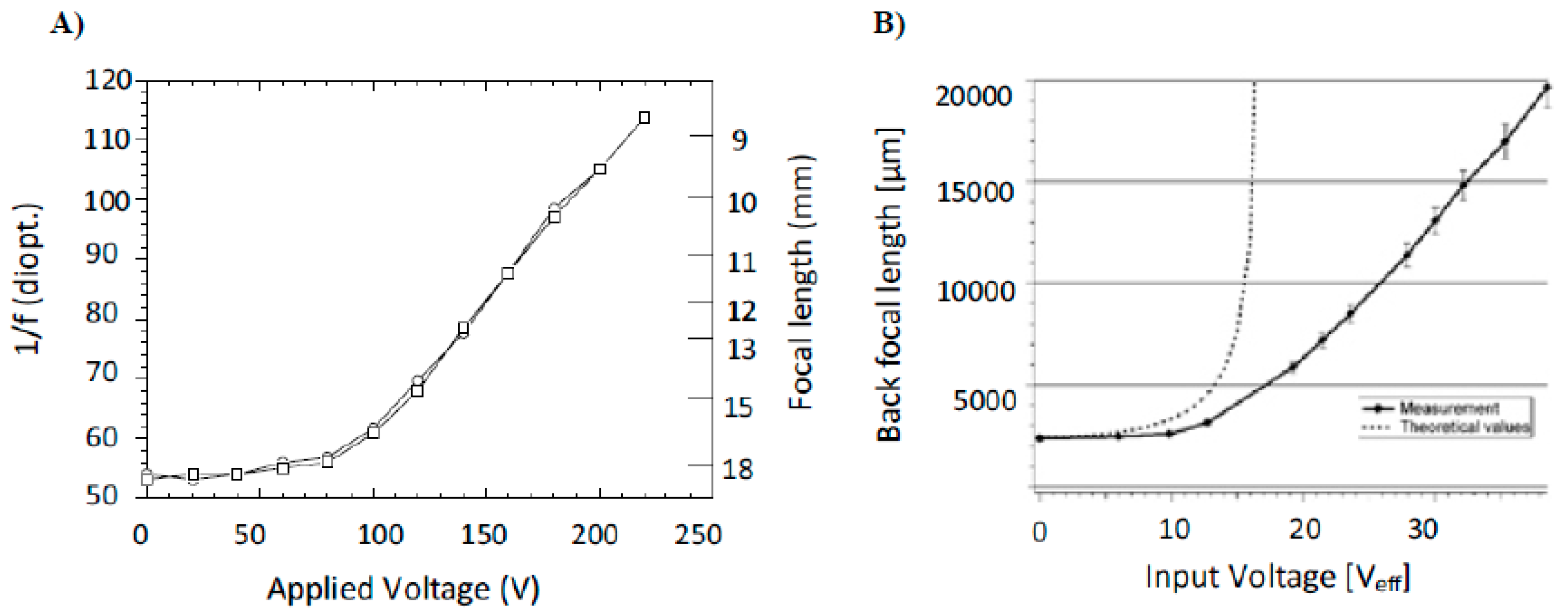

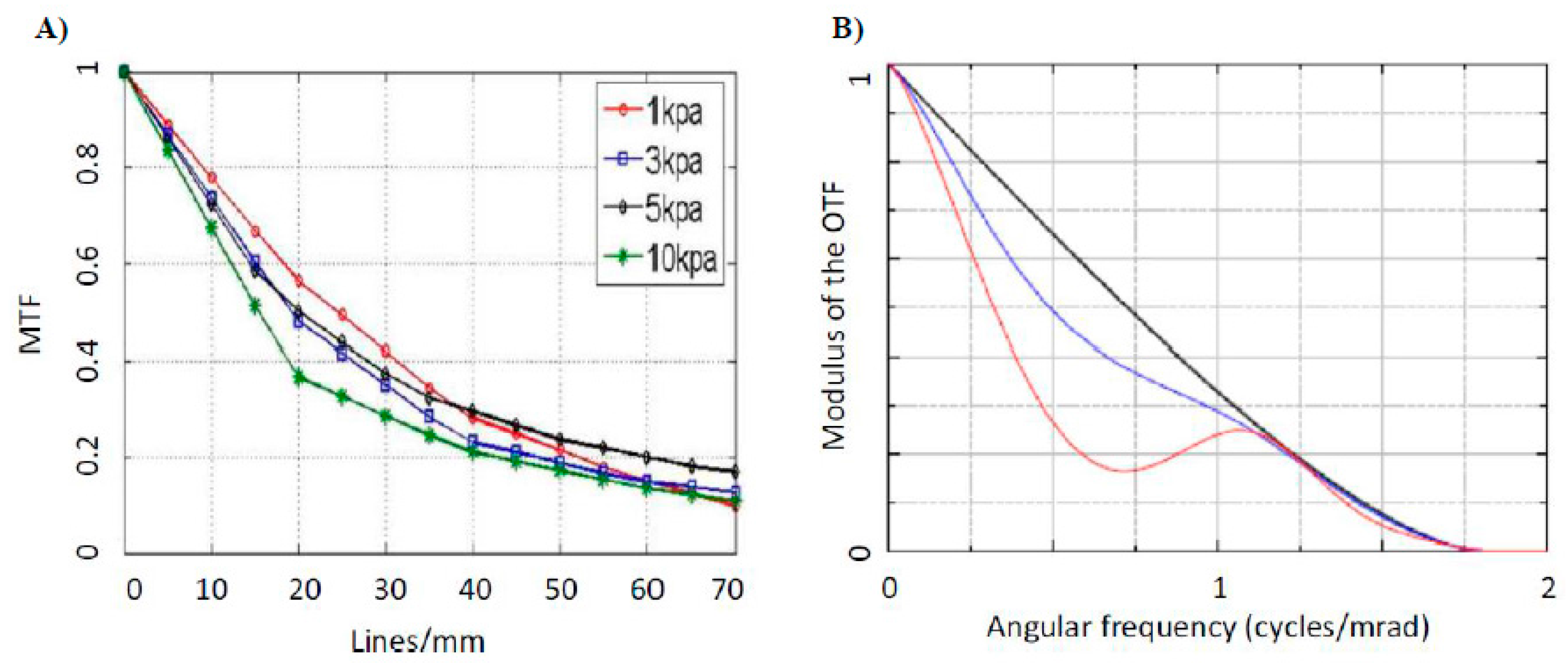
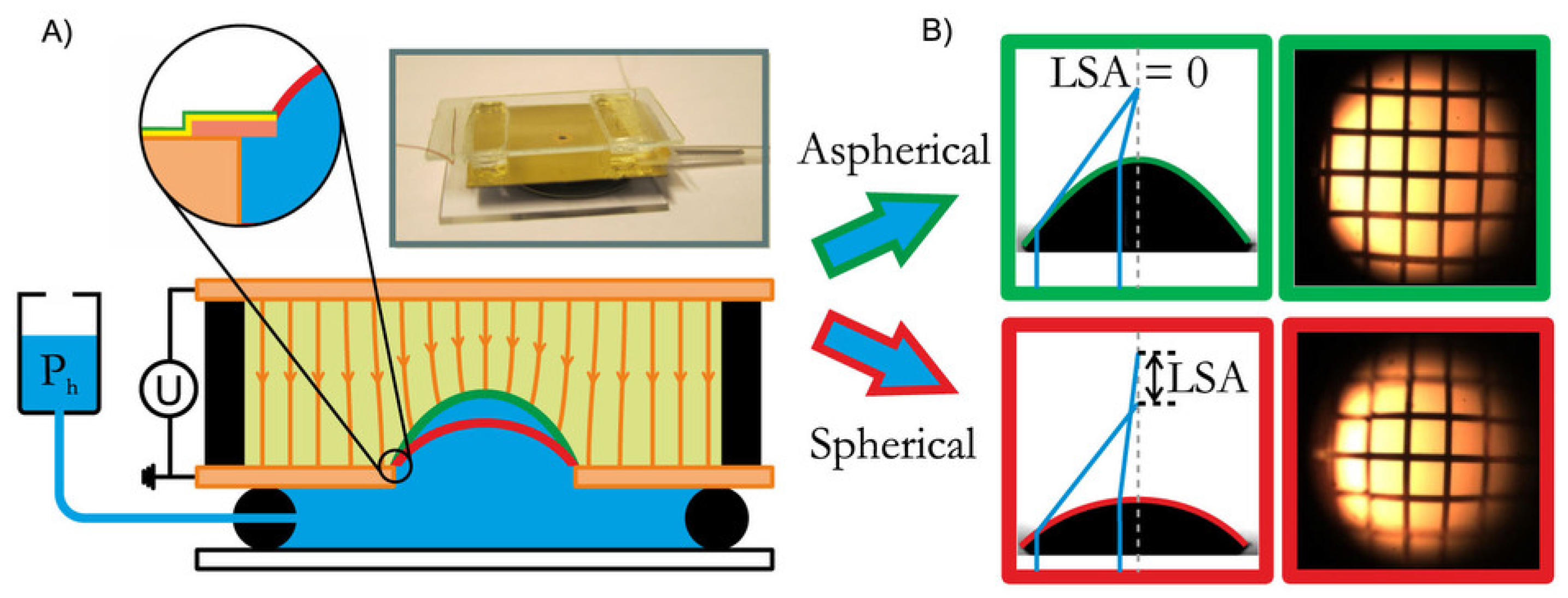


| Index | Radial Nodes (n) | Azimuthal Index (m) | Type of Aberration |
|---|---|---|---|
| 1 | 0 | 0 | piston |
| 2 | 1 | 1 | X-tilt (tip) |
| 3 | 1 | −1 | Y-tilt (tilt) |
| 4 | 2 | 0 | Defocus |
| 5 | 2 | −2 | Oblique astigmatism |
| 6 | 2 | 2 | Vertical astigmatism |
| 7 | 3 | −1 | Vertical coma |
| 8 | 3 | 1 | Horizontal coma |
| 9 | 3 | −3 | Vertical trefoil |
| 10 | 3 | 3 | Oblique trefoil |
| 11 | 4 | 0 | Primary spherical |
| 12 | 4 | 2 | Vertical secondary astigmatism |
| 13 | 4 | −2 | Horizontal secondary astigmatism |
| 14 | 4 | 4 | Vertical quadrafoil |
| 15 | 4 | −4 | Oblique quadrafoil |
© 2016 by the authors. Licensee MDPI, Basel, Switzerland. This article is an open access article distributed under the terms and conditions of the Creative Commons Attribution (CC-BY) license ( http://creativecommons.org/licenses/by/4.0/).
Share and Cite
Mishra, K.; Van den Ende, D.; Mugele, F. Recent Developments in Optofluidic Lens Technology. Micromachines 2016, 7, 102. https://doi.org/10.3390/mi7060102
Mishra K, Van den Ende D, Mugele F. Recent Developments in Optofluidic Lens Technology. Micromachines. 2016; 7(6):102. https://doi.org/10.3390/mi7060102
Chicago/Turabian StyleMishra, Kartikeya, Dirk Van den Ende, and Frieder Mugele. 2016. "Recent Developments in Optofluidic Lens Technology" Micromachines 7, no. 6: 102. https://doi.org/10.3390/mi7060102




